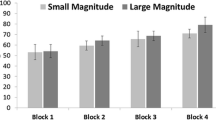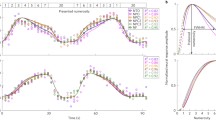Abstract
Previous studies have shown that elementary aspects of numerical abilities have developed in non-human primates. In the present study, we explored the potential for the development of a novel ability in the use of numerical operations by macaque monkeys (Macaca fuscata): adequate selection of a series of numerical actions toward achieving a behavioral goal. We trained monkeys to use a pair of devices to selectively add or subtract items to/from a digital array in order to match a previously viewed sample array. The monkeys determined whether to add or subtract on the basis of the feedback about numerosity given to the monkeys, which was displayed as an outcome of each step of the numerical operation. We also found that monkeys adapted flexibly to changes in the numerical rule that determined the relationship between device use and numerical operation. Our model analysis found that the numerosity-based model was a better fit for the monkeys’ performance than was the reward-expectation-based model. Such a capacity for goal-oriented selection of numerical operations suggests a mechanism by which monkeys use numerical representations for purposeful behaviors.





Similar content being viewed by others
References
Adams C, Dickinson A (1981) Instrumental responding following reinforcer devaluation. Q J Exp Psychol 33B:109–121
Akaike H (1974) New look at the statistical model identification. IEEE Trans Automat Contr AC-19:716–723
Ansari D (2008) Effects of development and enculturation on number representation in the brain. Nat Rev Neurosci 9:278–291
Balleine BW, O’Doherty JP (2010) Human and rodent homologies in action control: corticostriatal determinants of goal-directed and habitual action. Neuropsychopharmacology 35:48–69
Beran MJ (2007) Rhesus monkeys (Macaca mulatta) enumerate large and small sequentially presented sets of items using analog numerical representations. J Exp Psychol Anim Behav Process 33:42–54
Beran MJ, Beran MM (2004) Chimpanzees remember the results of one-by-one addition of food items to sets over extended time periods. Psychol Sci 15:94–99
Beran MJ, Rumbaugh DM (2001) “Constructive” enumeration by chimpanzees (Pan troglodytes) on a computerized task. Anim Cogn 4:81–89
Bongard S, Nieder A (2010) Basic mathematical rules are encoded by primate prefrontal cortex neurons. Proc Natl Acad Sci 107:2277–2282
Boysen ST, Berntson GG (1989) Numerical competence in a chimpanzee (Pan troglodytes). J Comp Psychol 103:23–31
Brannon EM, Terrace HS (1998) Ordering of the numerosities 1 to 9 by monkeys. Science 282:746–749
Breuer T, Ndoundou-Hockemba M, Fishlock V (2005) First observation of tool use in wild gorillas. PLoS Biol 2:e380
Cantlon JF, Brannon EM (2005) Semantic congruity affects numerical judgments similarly in monkeys and humans. Proc Natl Acad Sci 102:16507–16511
Cantlon JF, Brannon EM (2006) Shared system for ordering small and large numbers in monkeys and humans. Psychol Sci 17:401–406
Cantlon JF, Brannon EM (2007) Basic math in monkeys and college students. PLoS Biol 5:e328
Deaner RO, Khera AV, Platt ML (2005) Monkeys pay per views: adaptive valuation of social images by rhesus macaques. Curr Biol 15:543–548
Dehaene S, Changeux JP (1993) Development of elementary numerical abilities: a neuronal model. J Cogn Neurosci 5:390–407
Dehaene S, Marques JF (2002) Cognitive neuroscience: scalar variability in price estimation and the cognitive consequences of switching to the Euro. Q J Exp Psychol 55:705–731
Dehaene S, Dehaene-Lambertz G, Cohen L (1998) Abstract representations of numbers in the animal and human brain. Trends Neurosci 21:355–361
Dickinson A, Balleine B (1994) Motivational control of goal-directed action. Anim Learn Behav 22:1–18
Feigenson L, Dehaene S, Spelke E (2004) Core systems of number. Trends Cogn Sci 8:307–314
Flombaum JI, Junge JA, Hauser MD (2005) Rhesus monkeys (Macacamulatta) spontaneously compute addition operations over large numbers. Cognition 97:315–325
Gallistel CR, Gelman R (2000) Non-verbal numerical cognition: from reals to integers. Trends Cogn Sci 4:59–65
Hammond LJ (1980) The effects of contingencies upon appetitive conditioning of free-operant behavior. J Exp Anal Behav 34:297–304
Hauser MD, Spelke ES (2004) Evolutionary and developmental foundations of human knowledge: a case study of mathematics. In: Gazzaniga MD (ed) The cognitive neurosciences. MIT Press, Cambridge, MA, pp 853–864
Hauser MD, MacNeilage P, Ware M (1996) Numerical representations in primates. Proc Natl Acad Sci 93:1514–1517
Hauser MD, Carey S, Hauser LB (2000) Spontaneous number representation in semi-free-ranging rhesus monkeys. Proc R Soc Lond B 267:829–833
Matsuzawa T (1985) Use of numbers by a chimpanzee. Nature 315:57–59
Matsuzawa T (2009) The chimpanzee mind: in search of the evolutionary roots of the human mind. Anim Cogn 12:S1–S9
Moyer RS, Landauer TK (1967) Time required for judgments of numerical inequality. Nature 215:1519–1520
Mushiake H, Saito N, Sakamoto K, Sato Y, Tanji J (2001) Visually based path-planning by Japanese monkeys. Cogn Brain Res 11:165–169
Nieder A, Miller EK (2002) Representation of the quantity of visual items in the primate prefrontal cortex. Science 297:1708–1711
Nieder A, Diester I, Tudusciuc O (2006) Temporal and spatial enumeration processes in the primate parietal cortex. Science 313:1431–1435
Pica P, Lemer C, Izard W, Dehaene S (2004) Exact and approximate arithmetic in an Amazonian indigene group. Science 306:499–503
Saito N, Mushiake H, Sakamoto K, Itoyama Y, Tanji J (2005) Representation of immediate and final behavioral goals in the monkey prefrontal cortex during an instructed delay period. Cereb Cortex 15:1535–1546
Santos LR, Barnes JL, Mahajan N (2005) Expectations about numerical events in four lemur species (Eulemurfulvus, eulemurmongoz, lemur catta and varecianubra). Anim Cogn 8:253–262
Sawamura H, Shima K, Tanji J (2002) Numerical representation for action in the parietal cortex of the monkey. Nature 415:918–922
Schultz W (2000) Multiple reward signals in the brain. Nat Rev Neurosci 1:199–207
Shidara M, Richmond BJ (2002) Anterior cingulate: single neuronal signals related to degree of reward expectancy. Science 296:1709–1711
Sohn JW, Lee D (2006) Effects of reward expectancy on sequential eye movements in monkeys. Neural Netw 19:1181–1191
Sohn JW, Lee D (2007) Order-dependent modulation of directional signals in the supplementary and presupplementary motor areas. J Neurosci 27:13655–13666
Sulkowski GM, Hauser MD (2001) Can rhesus monkeys spontaneously subtract? Cognition 79:239–262
Washburn DA, Rumbaugh DM (1991) Ordinal judgments of numerical symbols by macaques (Macacamulatta). Psychol Sci 2:190–193
Watanabe M (1996) Reward expectancy in primate prefrontal neurons. Nature 382:629–632
Watanabe M, Cromwell HC, Tremblay L, Hollerman JR, Hikosaka K, Schultz W (2001) Behavioral reactions reflecting differential reward expectations in monkeys. Exp Brain Res 140:511–518
Acknowledgments
This work was supported by Core research for Evolutional Science & Technology (CREST) of Japan Science and Technology Agency (JST) and by Grants-in-Aid for Scientific Research, Ministry of Education, Science, and Culture, Japan (Grant no 22300124). We thank K. Shima, Y. Matsuzaka, K. Sakamoto, T. Nakajima, A. Mita, M. Kurama, and Y. Takahashi, for technical help, and N. Kanazawa for artwork.
Author information
Authors and Affiliations
Corresponding author
Electronic supplementary material
Below is the link to the electronic supplementary material.
Rights and permissions
About this article
Cite this article
Okuyama, S., Iwata, Ji., Tanji, J. et al. Goal-oriented, flexible use of numerical operations by monkeys. Anim Cogn 16, 509–518 (2013). https://doi.org/10.1007/s10071-012-0592-9
Received:
Revised:
Accepted:
Published:
Issue Date:
DOI: https://doi.org/10.1007/s10071-012-0592-9




